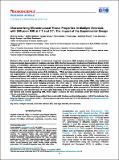Por favor, use este identificador para citar o enlazar a este item:
http://hdl.handle.net/10261/207966COMPARTIR / EXPORTAR:
 SHARE SHARE
 CORE
BASE CORE
BASE
|
|
| Visualizar otros formatos: MARC | Dublin Core | RDF | ORE | MODS | METS | DIDL | DATACITE | |

| Campo DC | Valor | Lengua/Idioma |
|---|---|---|
| dc.contributor.author | De Santis, Silvia | es_ES |
| dc.contributor.author | Bastiani, Matteo | es_ES |
| dc.contributor.author | Droby, Amgad | es_ES |
| dc.contributor.author | Kolber, Pierre | es_ES |
| dc.contributor.author | Zipp, Frauke | es_ES |
| dc.contributor.author | Pracht, Eberhard | es_ES |
| dc.contributor.author | Stoecker, Tony | es_ES |
| dc.contributor.author | Groppa, Sergiu | es_ES |
| dc.contributor.author | Roebroeck, Alard | es_ES |
| dc.date.accessioned | 2020-04-17T06:59:35Z | - |
| dc.date.available | 2020-04-17T06:59:35Z | - |
| dc.date.issued | 2019-04-01 | - |
| dc.identifier.citation | Neuroscience 403: 17-26 (2019) | es_ES |
| dc.identifier.issn | 0306-4522 | - |
| dc.identifier.uri | http://hdl.handle.net/10261/207966 | - |
| dc.description.abstract | The recent introduction of advanced magnetic resonance (MR) imaging techniques to characterize focal and global degeneration in multiple sclerosis (MS), like the Composite Hindered and Restricted Model of Diffusion, or CHARMED, diffusional kurtosis imaging (DKI) and Neurite Orientation Dispersion and Density Imaging (NODDI) made available new tools to image axonal pathology non-invasively in vivo. These methods already showed greater sensitivity and specificity compared to conventional diffusion tensor-based metrics (e.g., fractional anisotropy), overcoming some of its limitations. While previous studies uncovered global and focal axonal degeneration in MS patients compared to healthy controls, here our aim is to investigate and compare different diffusion MRI acquisition protocols in their ability to highlight microstructural differences between MS and control tissue over several much used models. For comparison, we contrasted the ability of fractional anisotropy measurements to uncover differences between lesion, normal-appearing white matter (WM), gray matter and healthy tissue under the same imaging protocols. We show that: (1) focal and diffuse differences in several microstructural parameters are observed under clinical settings; (2) advanced models (CHARMED, DKI and NODDI) have increased specificity and sensitivity to neurodegeneration when compared to fractional anisotropy measurements; and (3) both high (3 T) and ultra-high fields (7 T) are viable options for imaging tissue change in MS lesions and normal appearing WM, while higher b-values are less beneficial under the tested short-time (10 min acquisition) conditions. | es_ES |
| dc.description.sponsorship | SDS is supported by a NARSAD Young Investigator Grant (Grant #25104) and by the European Research Council through a Marie Skłodowska-Curie Individual Fellowship (Grant #749506). MB is supported by the European Research Council under the European Union's Seventh Framework Programme (FP/2007-2013/ERC Grant Agreement #319456). This work was also supported by a grant from Federal Ministry for Education and Research (BMBF, KKNMS, project MSNetworks) to SG and FZ. AR is supported by Netherlands Organisation for Scientific Research through a VIDI grant (#14637). | es_ES |
| dc.language.iso | eng | es_ES |
| dc.publisher | Elsevier | es_ES |
| dc.relation | info:eu-repo/grantAgreement/EC/H2020/749506 | es_ES |
| dc.relation | info:eu-repo/grantAgreement/EC/FP7/319456 | es_ES |
| dc.relation.isversionof | Publisher's version | es_ES |
| dc.rights | openAccess | es_ES |
| dc.subject | Multiple sclerosis | es_ES |
| dc.subject | Multi-shell diffusion MRI | es_ES |
| dc.subject | Ultra-high field MRI | es_ES |
| dc.subject | Microstructure | es_ES |
| dc.title | Characterizing microstructural tissue properties in multiple sclerosis with diffusion MRI at 7 T and 3 T: The impact of the experimental design | es_ES |
| dc.type | artículo | es_ES |
| dc.identifier.doi | 10.1016/j.neuroscience.2018.03.048 | - |
| dc.description.peerreviewed | Peer reviewed | es_ES |
| dc.relation.publisherversion | https://doi.org/10.1016/j.neuroscience.2018.03.048 | es_ES |
| dc.identifier.e-issn | 1873-7544 | - |
| dc.rights.license | https://creativecommons.org/licenses/by-nc-nd/4.0/ | es_ES |
| dc.contributor.funder | European Research Council | es_ES |
| dc.contributor.funder | Brain and Behavior Research Foundation | es_ES |
| dc.contributor.funder | Federal Ministry of Education and Research (Germany) | es_ES |
| dc.contributor.funder | Netherlands Organization for Scientific Research | es_ES |
| dc.relation.csic | Sí | es_ES |
| oprm.item.hasRevision | no ko 0 false | * |
| dc.identifier.funder | http://dx.doi.org/10.13039/501100002347 | es_ES |
| dc.identifier.funder | http://dx.doi.org/10.13039/501100000781 | es_ES |
| dc.identifier.funder | http://dx.doi.org/10.13039/100000874 | es_ES |
| dc.type.coar | http://purl.org/coar/resource_type/c_6501 | es_ES |
| item.openairetype | artículo | - |
| item.grantfulltext | open | - |
| item.cerifentitytype | Publications | - |
| item.openairecristype | http://purl.org/coar/resource_type/c_18cf | - |
| item.fulltext | With Fulltext | - |
| item.languageiso639-1 | en | - |
| Aparece en las colecciones: | (IN) Artículos | |
Ficheros en este ítem:
| Fichero | Descripción | Tamaño | Formato | |
|---|---|---|---|---|
| 2019_DeSantis_Neuroscience_MS.pdf | 2,02 MB | Adobe PDF |  Visualizar/Abrir |
CORE Recommender
SCOPUSTM
Citations
49
checked on 13-abr-2024
WEB OF SCIENCETM
Citations
44
checked on 22-feb-2024
Page view(s)
132
checked on 18-abr-2024
Download(s)
276
checked on 18-abr-2024
Google ScholarTM
Check
Altmetric
Altmetric
Este item está licenciado bajo una Licencia Creative Commons

